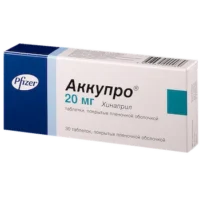Description
Amlodipine SAN Tablets 5 mg. №30
Ingredients:
Each tablet contains 5 mg of Amlodipine.
Mechanism of Action:
Amlodipine is a calcium channel blocker that works by relaxing blood vessels, thereby reducing peripheral vascular resistance and decreasing blood pressure. This action leads to improved oxygen delivery to the heart muscle and decreased workload on the heart.
Pharmacological Properties:
Amlodipine belongs to the dihydropyridine class of calcium channel blockers. It selectively inhibits the influx of calcium ions across cell membranes in cardiac and vascular smooth muscle without affecting serum calcium levels.
Indications for Use:
Amlodipine SAN tablets are indicated for the treatment of hypertension (high blood pressure) and chronic stable angina (chest pain).
Contraindications:
Do not use Amlodipine if you have a known hypersensitivity to amlodipine or other dihydropyridines. It is contraindicated in patients with severe hypotension or shock.
Side Effects:
Common side effects of Amlodipine may include peripheral edema (swelling in the ankles or feet), dizziness, headache, and flushing. Rare but serious side effects may include palpitations, bradycardia, and hepatotoxicity.
Usage Instructions:
The recommended dosage of Amlodipine SAN tablets is one 5 mg tablet once daily. The tablets should be taken orally with a glass of water, with or without food. Do not crush or chew the tablets.
Benefits Compared to Analogues:
Amlodipine has a long duration of action, allowing for once-daily dosing and better patient compliance compared to some other antihypertensive medications. Its vasoselectivity and minimal negative inotropic effects make it a preferred choice in the management of hypertension.
Suitable Patient Groups:
Amlodipine is suitable for use in adult patients, including the elderly, who require antihypertensive therapy. It is not recommended for use in children under 6 years of age due to limited data on safety and efficacy in this population.
Storage and Shelf Life:
Store Amlodipine SAN tablets in a cool, dry place at room temperature. Keep the tablets in their original packaging to protect them from moisture. Check the expiration date on the packaging and do not use the tablets beyond this date.
Packaging Description:
Amlodipine SAN tablets are packaged in blister packs containing 30 tablets each. The blister packs are designed to ensure the integrity and stability of the tablets until they are used.





